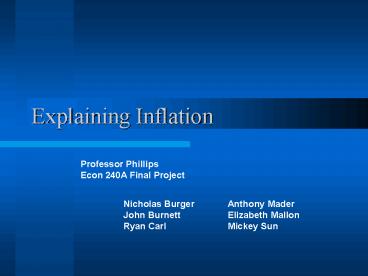Explaining Inflation - PowerPoint PPT Presentation
1 / 16
Title:
Explaining Inflation
Description:
Mickey Sun. Objective. Determine if inflation can be explained by changes in the M3 money supply, ... M3 money supply (billions of dollars) federal budget ... – PowerPoint PPT presentation
Number of Views:197
Avg rating:3.0/5.0
Title: Explaining Inflation
1
Explaining Inflation
Professor Phillips Econ 240A Final Project
Nicholas Burger John
Burnett Ryan Carl
Anthony Mader Elizabeth Mallon Mickey Sun
2
Objective
- Determine if inflation can be explained by
changes in the M3 money supply, federal funds
rate, productivity, and federal budget
deficit/surplus - Regression model
- Dependent variable
- CPI (1982100)
- Independent variables
- M3 money supply (billions of dollars)
- federal budget deficit/surplus (billions of
dollars) - productivity index (output/hour)
- federal funds rate ()
- H0 ?1 ?2 ?3 ?4 0
- HA At least one ? ? 0
3
Data Collection
- Relevant data obtained at http//research.stlouisf
ed.org/fred - Data analyzed quarterly
4
Exploratory Analysis
- M3 and Output are directly proportional with CPI
- FFR and Federal Budget Deficit/Surplus are
oscillatory while CPI increases
5
Results- Model 1
- T-statistic highly significant for all variables
but FFR - High R2 value (0.980) and high F-statistic
(2781.589) - Low Durbin-Watson statistic (0.07)
6
Results- Model 1
- Model follows data well up to 1990
- Increased deviation between actual and fitted
coinciding with 1991-2001 expansion
7
Results- Model 2
- First Model t-statistic for FFR did not give
evidence for a linear relationship between FFR
and CPI - We ran the regression without this independent
variable to see if it significantly improved the
validity of our model.
8
Results- Model 2
- T-statistics are highly significant and R2 value
unchanged at 98 - F-statistic improved to 4161.575
- Durbin-Watson statistic still indicates
auto-correlation
9
Results- Model 3
- We also attempted to correct for the apparent
lack of correlation between CPI and FFR. - Changes in the FFR take time to effect the
economy (lag time of 9-18 months). - Therefore, we shifted the FFR data forward by
9-18 months and regressed against CPI.
10
Results- Model 3
- The 9, 12, and 18 month shifts produced
t-statistics for FFR of 0.488, 0.412, and 0.3928
respectively. - The regression failed to improve the explanatory
power of FFR on the behavior of CPI.
11
Results- Model 4
- We attempted to correct the auto-correlation
present in our model. - We ran the regression using the change in each
variables value from the previous quarter.
12
Results- Model 4
- Coefficient for productivity is negative and the
Durbin-Watson statistic increased to 0.57 - R2 decreased dramatically to 0.139 and
F-statistic dropped, although still significant
at the 5 level
13
Results- Model 5 (The Last One!)
- In order to correct autocorrelation, we developed
another regression model. - We added an independent variable to the model
that has a time-ordered effect on the dependent
variable.
14
Results- Model 5
- All variables are linearly related to CPI at the
5 significance level - The R2 value and f-statistic both increased
- The Durbin-Watson statistic increased
15
Results- Model 5
- This final model follows the data most closely of
all the regressions investigated as reflected by
the actual-fitted-residual curves.
16
Conclusions
- The CPI is negatively correlated with the federal
funds rate and productivity, while the CPI is
positively correlated with the government budget
deficit/surplus and M3 money supply. - In order to achieve an accurate model for the
relationship between the dependent and
independent variables, a time-ordering variable
must be introduced into the regression.































